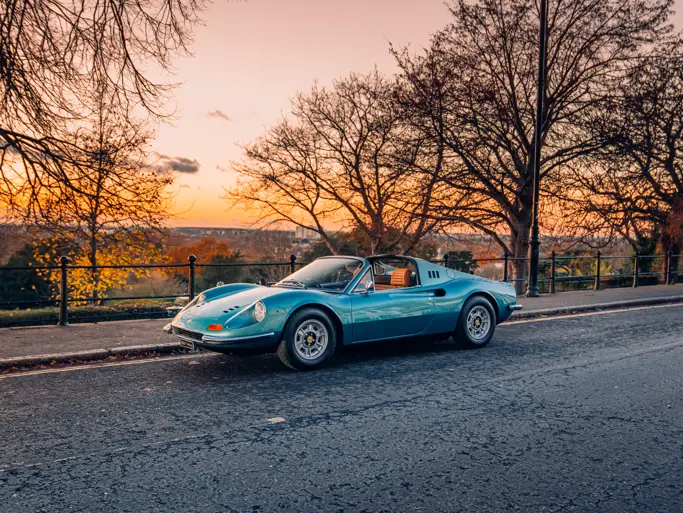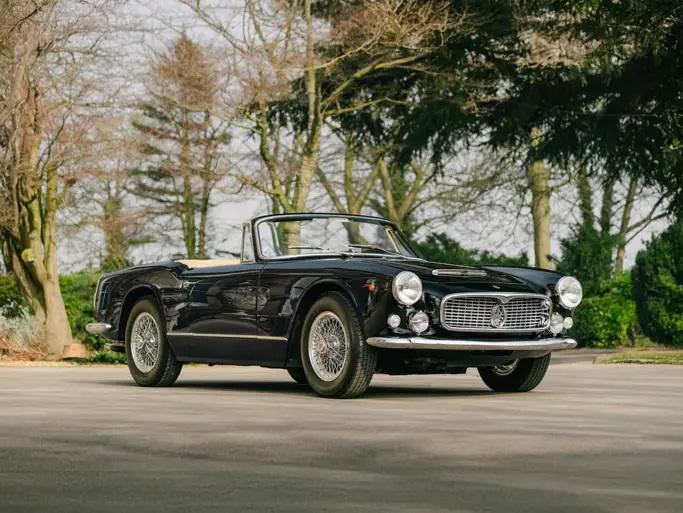1966 Ferrari 330 GT 2+2 Series II by Pininfarina
{{lr.item.text}}
$308,000 USD | Sold
{{bidding.lot.reserveStatusFormatted}}
- Highly original example, with three documented owners from new
- Maintained for 40 years by the third owner
- Extensive mechanical restoration by marque experts
- Impressive original paint and interior
300 bhp 3,967 cc SOHC V-12 engine, three Weber 40 DCZ/6 carburetors, independent unequal length wishbone front suspension with coil springs, live rear axle with semi-elliptic leaf springs and coil springs over telescopic shock absorbers, and Dunlop dual-circuit four-wheel disc brakes. Wheelbase: 104 in.
As Enzo Ferrari sought to update his lucrative grand touring coupe lineup, the 330 was conceived as a successor to his marque’s legendary and long-lived 250 series.
While Ferrari’s efforts primarily remained centered around racing cars, it was the sale of road going models to well-heeled, discerning customers that financed those efforts. This symbiotic relationship was obvious once one opened the hood of the first 330, the 330 America. The company’s new Tipo 209 V-12 engine displaced 3,967 cubic centimeters (330 cubic centimeters per cylinder, which gave the car its name) and boasted a slightly longer block than its 400 SA series predecessor. The engine was rated at 300 horsepower, and the 12 cylinders were fed by a trio of Weber 40 DCZ/6 carburetors. Befitting of the car’s highway cruising aim, the 330 used a four-speed gearbox with an overdrive unit.
The 330 America was, however, a short-lived placeholder for what was to come: the 330 GT 2+2. It was introduced in January 1964 at the Brussels Motor Show, where it generated a high degree of controversy for its quad headlamp arrangement, which was penned by Pininfarina’s noted American designer Tom Tjaarda. Although today’s enthusiasts find it’s mid-century look to be distinctive, to today’s enthusiasts, it was subsequently replaced with a more conventional twin headlamp arrangement a year later, when the Series II hit the market.
Regardless of the number of eyebrows raised by the 330 GT 2+2’s styling, it was undoubtedly a “grander” tourer for Ferrari. The 330 rode on a two-inch longer wheelbase than the 250 GTE, and it included such advanced engineering features, as Koni adjustable shock absorbers and a Dunlop dual-circuit braking system that gave both the front disc and rear disc brakes their own servo-assist. A true five-speed gearbox arrived in 1965 to replace the overdrive unit, but approximately 125 “interim” examples do exist with quad headlamps and the additional gear.
Only 455 examples of the handsome Series II 330 GT were built before the more aggressive yet less stately 365 GT arrived in 1967.
With just three owners during its nearly 50 year history, this 1965 330 GT 2+2 Series II is a rare and highly-documented example of one of Ferrari’s earliest 2+2 success stories. It was delivered new to its first owner in Cremona, Italy, and it boasts the unique arrangement of the Series II’s single headlamps being paired with the more elegant, original Series I dashboard, which was presumably a special order at the time. In February 1966, it was completed by Pininfarina in Turin, Italy, wearing Argento metallic over Nero leather with red carpeting, and it was highly specified with cast alloy wheels, power windows, and a Blaupunkt audio system; all of which remain with it today.
The silver 330 GT 2+2 didn’t stay long in Italy, and within five years, well-known enthusiast Raymond S. Boniface, of Poland, Ohio, acquired the car in Italy and had it shipped home to the U.S. Although Boniface’s ownership of the car lasted only five years, it remained in Ohio with its next owner for the next four decades. In 1974, it was acquired, with 68,252 kilometers on its odometer, by Jim Gerken, from Deetz Mercedes-Benz in Elyria, Ohio, and it remained under his fastidious care until recently. Today, it displays about 85,000 original kilometers (approximately 52,000 miles).
A folder of service records indicates a highly regimented maintenance schedule was maintained. Within the last 10 years alone, the 330 GT 2+2 was treated to an extensive powertrain overhaul by Ferrari expert Wayne Obry’s Motion Products, of Neenah, Wisconsin, at a cost exceeding $120,000. Under its long hood sits its original matching-numbers engine, which is now rebuilt.
This highly drivable 330 GT 2+2 is independently reported to make excellent power without emitting any smoke. Its gearbox operates smoothly, as its clutch and master cylinder have both been recently replaced. Its suspension is soft and compliant, riding exactly as Enzo himself had envisioned 50 years ago. Its original factory-applied Argento paint and Nero leather show but mere hints of patina; while, as might be expected with its age and originality, there is some wear evident in the Ferrari’s red carpeting. Remarkably, its body remains impressive, with its excellent panel fit still just as Pininfarina had intended.
This Ferrari is offered in genuine time-capsule condition, with an excellent interior and original paint, which is coupled with extensive, expert attention to its mechanical systems, and it represents a rare ownership proposition. It has benefited from a recent, thorough detailing, which renders it a compelling candidate for Preservation Class competition at concours events, and it is believed with confidence that it could be enthusiastically driven both to and from any gathering of Ferraristi.
Titled as 1967.

 | Phoenix, Arizona
| Phoenix, Arizona


